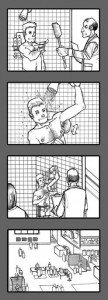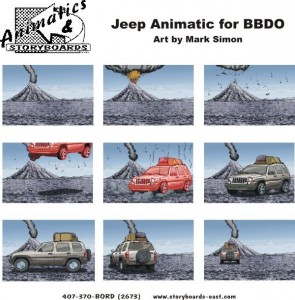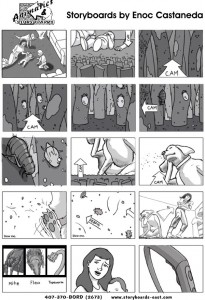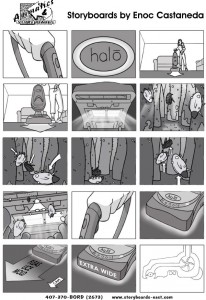What is a storyboard?
Once a concept or script is written for a film or animation, the next step is to make a storyboard. A storyboard visually tells the story of an animation panel by panel, kind of like a comic book.
Your storyboard should convey some of the following information:
- What charaters are in the frame, and how are they moving?
- What are the characters saying to each other, if anything?
- How much time has passed between the last frame of the storyboard and the current one?
- Where the “camera” is in the scene? Close or far away? Is the camera moving?
Why make a storyboard?
Creating a storyboard will help you plan your animation out shot by shot. You can make changes to your storyboard before you start animating, instead of changing your mind later. You will also be able to talk about your animation and show your storyboard to other people to get feedback on your ideas.
How do I make a storyboard?
Most commonly, storyboards are drawn in pen or pencil. If you don’t like to draw you can also take photos, cut out pictures from magazines, or use a computer to make your storyboards. Keep in mind that your drawings don’t have to be fancy! In fact, you want to spend just a few minutes drawing each frame. Use basic shapes, stick figures, and simple backgrounds. If you draw your storyboard frames on index cards, you can rearrange them to move parts of the the story around.
Examples:
Here is the storyboard and commercial for a car so you can get the idea.
his was done as a possible TV commercial campaign for Taco Bell called “Tested on Animals”. The idea was for Taco Bell Scientists to take college student subjects into their lab and study the further possibilities of the tacos. I worked under Jeffery Hyman’s (Cog1.com) creative direction.
Assignment:
Plan your own commercial!
1. Choose the Product
1. Must be a real product.
2. Must be able to bring product to school
3. Must be able to shoot commercial at school
4. Must be approved by teacher.
2. Study the product
A. What’s unique?
B. Why is it better?
C. How can it be positioned amongst the competition?
3. Identify and study the target audience.
A. Who likes this type of product?
B. How will the target audience use the product?
C. How can the product gain recognition from the target audience?
4. Design an advertising campaign
A. Choose one of the Persuasive techniques
B. Motivate audience to action – buy product, vote for candidate, etc.
3. Make a storyboard
1. Include at least 6 frames
2. Include different size shots
3. Sketch or take pictures to show the different shots
4. Use arrows to show movement
5. Write a description of the commercial as well.



